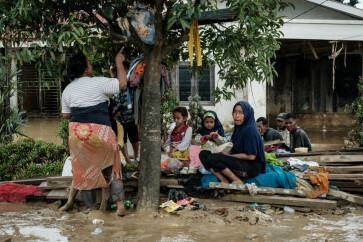Popular Reads
Top Results
Can't find what you're looking for?
View all search resultsPopular Reads
Top Results
Can't find what you're looking for?
View all search resultsSleman stops sand mining activities at Mt. Merapi
The Sleman regency administration in Yogyakarta province officially discontinued river normalization activities and sand quarrying in rivers originating from the Mount Merapi in an effort to maintain the ecology and environment
Change text size
Gift Premium Articles
to Anyone
T
he Sleman regency administration in Yogyakarta province officially discontinued river normalization activities and sand quarrying in rivers originating from the Mount Merapi in an effort to maintain the ecology and environment.
Since 2010, Mt. Merapi eruptions have resulted in the contamination of a number of rivers with volcanic material. In an effort to restore rivers and minimize the impact of cold lava flow, the Sleman administration issued a policy on river normalization through dredging with the use of heavy machinery.
'We will reorganize and map out the rivers and officially stop the normalization activities until further notice,' said Sleman Energy, Mineral and Water Resources Agency head Purwanto.
River restoration is also aimed at creating river basins to retain volcanic material carried by rain water. 'The basins found in a number of locations will minimize the impact of cold lava flow,' said Purwanto.
Based on a regency decree dated Dec. 11, all sand quarrying activities in Gendol, Opak, Kuning, Worodan and Krasak rivers have officially been stopped.
'Besides the use of heavy machinery, traditional sand quarrying activities by local residents have also been banned,' said Purwanto.
However, even though areas permitted or banned from mining have been set clearly, there continues to be violations.
'[Sand] Mining is associated with residents' livelihood following the Mt. Merapi eruption, so those affected will not give up. They even stage protests whenever there is a raid [carried out by officials],' said Purwanto.
Chief of Kepuhardjo village, Cangkringan, Heri Suprapto, admitted that residents were still engaged in sand mining activities on private property despite the detriment to the environment.
Yogyakarta Geological Disaster Technology Development and Research Center head Subandriyo acknowledged that the move to halt sand quarrying was positive for the environment.
'Mt. Merapi produces 1.2 million cubic meters of volcanic materials annually, while its mining volume is more than 5 million cubic meters. If left unchecked, a deficit in material could occur and damage the environment,' said Subandriyo.
Separately, Sleman Independent Monitoring Forum (Forpi) spokesman Taufik Hidayat said river sand quarrying on the slope of Mt. Merapi was currently full of vested interests as lots of the heavy machinery involved in river normalization activities were owned by officials.
'This is associated with the high economic value and huge volume of Merapi materials sought after by people. Most of the heavy machinery units are owned by officials, including those from the police, local administrations, prosecutor's office and legislators,' said Taufik.










